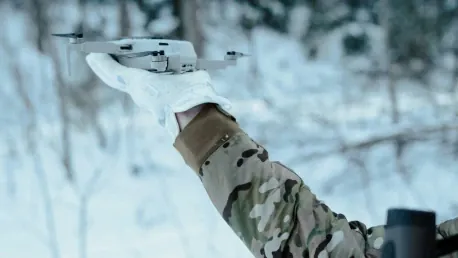The U.S. Army is accelerating efforts to enhance its counter-drone capabilities in response to the increasing threat posed by enemy drones, particularly small and low-cost micro-drone explosives. This initiative leverages artificial intelligence (AI) and advanced computing technologies to develop more efficient and adaptable defense systems. The motivation behind these advancements is to ensure the Army can protect both stationary and mobile assets in various operational environments against evolving drone threats. The technology-driven approach seeks to stay ahead of adversaries who continually refine their drone warfare tactics.
Understanding the Rising Threat of Enemy Drones
Recent conflicts involving Russia, Ukraine, and the Middle East have highlighted the growing sophistication and prevalence of drone warfare. Autonomous systems and low-cost lethal weapons are becoming common, making traditional defense systems vulnerable to being overwhelmed. Small drones, easily available and relatively inexpensive, can be used to carry out surveillance, deliver explosives, or jam communication systems. The integration of cyber warfare capabilities with drone technologies further amplifies the capacity for coordinated attacks that can disrupt and damage critical operations.
The Pentagon, through entities such as Army Futures Command and its Army Applications Laboratory (AAL), is prioritizing the development of advanced Counter-Unmanned Aerial Systems (C-UAS) technologies. This strategic focus is paramount to keeping pace with the rapid evolution of threats posed by enemy drones. By concentrating efforts on cutting-edge technological solutions, the U.S. Army aims to develop a robust network of defenses capable of neutralizing the diverse dangers drones present. The combined use of state-of-the-art systems seeks to mitigate risks and offer a proactive defense strategy.
Pentagon’s Emphasis on Advanced C-UAS Technologies
The Army Applications Laboratory is responsible for spearheading the integration of artificial intelligence and non-kinetic measures to enhance the Army’s counter-drone capabilities. This focus ensures that the military can adopt and deploy cutting-edge technology swiftly, providing a distinct advantage over adversaries. The integration of AI is particularly crucial in automating and accelerating threat detection and response processes, making defense mechanisms more efficient. Advanced algorithms allow for rapid data analysis, interpreting vast amounts of information to accurately identify and counteract drone threats.
Collaborating with universities, private sector innovators, and other government agencies, the AAL aims to harness emerging technologies. This collaboration is instrumental in generating various solutions to meet both stationary and mobile C-UAS defense needs. By drawing upon a broad spectrum of knowledge and expertise, the AAL can explore innovative approaches and technologies that might not be immediately apparent within military circles alone. Cross-sector partnerships help in the rapid development and deployment of effective C-UAS systems tailored to the multifaceted nature of modern combat scenarios.
Tackling On-The-Move Defense Challenges
One of the primary challenges is enhancing C-UAS capabilities for moving units and assets, as they face different threats compared to fixed positions. Developing technologies that provide rapid detection, discrimination, fire-control, and threat validation is essential. Mobile units, such as convoys, need defense systems that can operate in real time, adapting to the fluid and unpredictable dynamics of the battlefield. These systems must seamlessly integrate with existing military equipment without compromising mobility or operational efficiency.
Innovations in miniaturizing advanced drone defenses to fit mobile platforms, such as vehicles and small robots, are crucial. These efforts aim to deliver effective protection and enable rapid adaptation in dynamic operational environments. By incorporating smaller, more flexible defense systems, military units can maintain heightened vigilance and preparedness while on the move. These miniaturized systems are designed for quick deployment and ease of use, ensuring that soldiers can respond swiftly to threats in fast-paced combat situations.
Leveraging AI-Enabled Systems and Edge Computing
AI-powered systems are critical in processing incoming sensor data, performing real-time analysis, and determining optimal defensive measures. These systems must handle complex environments that feature obstacles like fog, smoke, or electronic interference. AI ensures that data is analyzed and acted upon swiftly, reducing decision-making times and increasing the likelihood of successfully countering drone attacks. Moreover, the use of sophisticated machine learning algorithms allows these systems to improve over time, becoming more capable of predicting and responding to threats.
Computing at the edge is vital for ensuring that AI-enabled systems can operate efficiently in compromised environments. This approach minimizes the delay in decision-making, providing an edge in fast-paced scenarios. Edge computing involves processing data closer to the source rather than relying on centralized data centers. This decentralized method enhances speed and reliability, crucial in active combat zones where immediate responses are necessary. The distributed processing capability of edge computing ensures that even under challenging conditions, vital data is swiftly processed to facilitate rapid response.
Enhancing Human-AI Synergy
Integrating high-speed AI-enabled computing with human cognition ensures optimal decision-making capability. Machines can handle procedural and analytical functions swiftly, while humans focus on nuanced, subjective judgments. This collaboration between AI and human operators creates a balanced system where the strengths of each component are maximized. While AI excels at data processing and predictive analysis, human soldiers bring their intuition and experience to bear, providing strategic insights that machines cannot replicate.
This synergy between humans and AI is pivotal in maximizing the overall efficacy and adaptability of C-UAS systems. It strikes a balance between rapid data processing and essential human oversight. As a result, defense mechanisms are not only quick and precise but also adaptable to complex and unforeseen circumstances. Soldiers are thus better equipped to make informed decisions, guided by the streamlined and accurate input provided by AI systems, ensuring robust protection against drone threats in varied operational contexts.
Exploring Kinetic and Non-Kinetic Solutions
Electronic warfare, high-powered microwave, and laser technologies are among the potential countermeasures being developed. These non-kinetic solutions can disable or jam incoming drone threats effectively without causing significant collateral damage. For instance, electronic jamming can interfere with a drone’s navigation and communication systems, rendering it inoperable. High-powered microwaves can disrupt and damage a drone’s electronic components, neutralizing the threat. These non-kinetic measures are particularly valuable in populated or complex environments where traditional kinetic solutions might not be feasible.
Kinetic solutions, such as traditional missile and gun-based defenses, remain relevant and necessary. These methods provide a reliable and straightforward approach to physically intercept and destroy drones. However, non-kinetic measures are particularly valuable in minimizing collateral damage and ensuring effective countermeasures in densely populated or sensitive areas. By combining kinetic and non-kinetic solutions, the Army can tailor its response to the specific operational needs and environmental constraints, ensuring comprehensive and adaptable drone defense strategies that can meet the challenges posed by diverse enemy tactics.
Future Considerations and Strategic Emphasis
The U.S. Army is fast-tracking initiatives to boost its counter-drone capabilities as it faces mounting threats from enemy drones, especially small, inexpensive micro-drone explosives. By leveraging artificial intelligence (AI) and advanced computational technologies, the Army aims to create more efficient and flexible defense systems. The primary goal of these advancements is to ensure the Army can shield both stationary and mobile assets in diverse operational environments from the continually evolving dangers posed by drones. This technology-focused strategy is designed to maintain an edge over adversaries who are constantly enhancing their drone warfare techniques. Adopting a proactive stance, the Army is dedicated to staying ahead in the fast-paced domain of drone warfare by evolving and upgrading its defensive strategies as these technologies advance. This approach underscores the importance of agility and innovation in modern military operations, ensuring that the Army remains capable of effectively countering present and future drone threats.









